Woodworm attacks on wood are feared by woodworkers and owners of furniture, floors, attics and other wooden structures. It is an insect that is not easily escaped, that manages to infest other surrounding woodwork over time and can be fatal to valuable old pieces of furniture. In the past, treatments against wood decay were very aggressive and woodworkers often preferred to burn the wood if they discovered wood decay holes. The desire to save valuable pieces and the ban on the use of very aggressive and toxic substances (DDT or lindane) has increased interest in methods and materials that are as gentle as possible to humans and animals. I will tell you more about such treatments.
What are cavities
The term woodworm refers to one of the developmental stages of this insect. There are several insects that go by this name, but the one we call a woodworm is Anobium Punctatum. It feeds on the softer part of the wood (the sapwood) and does not pose a hazard to the supporting structures as the heartwood is protected. However, there is a much more dangerous pug - Xestobium rufovillosum - which also attacks the hard part of the wood. Fortunately, it is rare here.
The insect has 3 stages of development - egg, larva and adult. About development cycles, appearance, egg-laying we have said more here. The idea is that when it becomes an adult, the insect leaves the wood and lives only as long as it lays eggs, after which it dies. The eggs remain in the wood and develop into larvae that feed on the wood. During its larval life the carrion can burrow deep into the wood. When the time comes for it to become an adult, it approaches the surface of the wood so that the insect that will emerge from the pupa can easily break through the wood to the surface. This produces those distinctive round holes, which announce the presence of the hornbill.
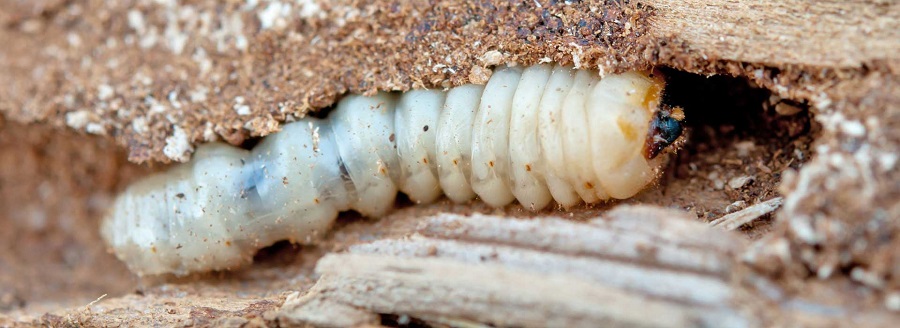
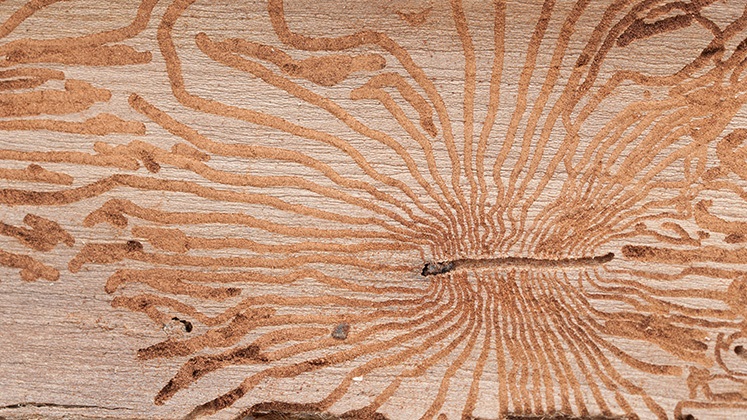
How they get into wood and under what conditions they thrive
The insects get into the wood by contamination from already infested wood. I said the adult insect lays eggs and then dies. The eggs are laid on the surface of wood that is not protected with specific products, in existing cracks and are not visible.
Eggs can survive for years in conditions that are not conducive to their transformation into larvae. For this reason it is often difficult to get rid of the quarry. Eggs can survive less aggressive treatments. On the surface we may think we have removed the danger, but as soon as conditions become favorable the larvae emerge and start eating the wood.
Favorable conditions mean humidity of at least 10% at 13-23ºC. Thistles love moisture and moderate heat. They grow very well in wood with humidity of 18-201TP33T. They occur in storage places (cellars, attics, attics) where humidity is high.
Their occurrence also depends on the type of wood. The Resinful that have the resin distributed throughout the wood (not just under the bark) is more protected. This is the case spruce wood, larch or douglas. And hardwood, like oak tree or acaciais more protected. The carrion will only attack the sapwood area, the heartwood being too tough for it.
How to recognize their presence
First of all, the presence of the carina is given by the hollow of the specific holes. They are round, with a diameter of around 1 mm, and are grouped in clusters. In the case of furniture or floorboards they are placed near the joints.
Holes in the wood show that the larva has turned into an adult and emerged from the wood. So it is possible to have holes even without a carrion inside. However, if wood dust appears next to these holes, the larva is definitely inside. If you find such holes, clean the place thoroughly to remove the dust and come back a day later to see if the wood dust has reappeared. This is sure proof that there are wood decay.
Another identification is the specific noise the larvae make when gnawing wood. If the house is completely quiet you will hear this noise and recognize it immediately.
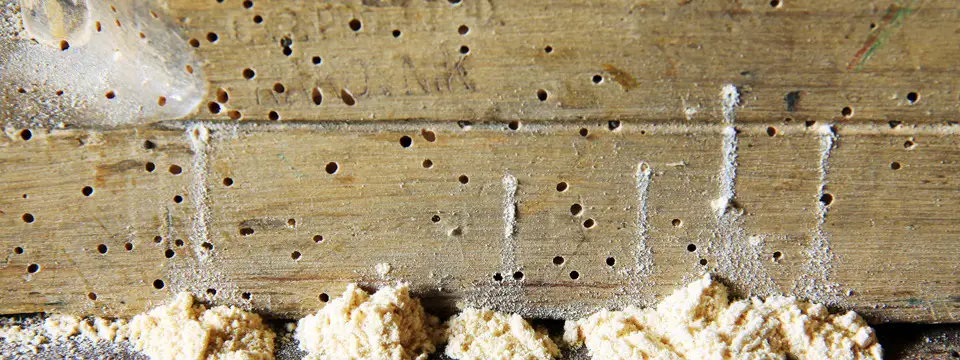
How they can be prevented
It is safest, where possible, to treat wood that is exposed to high humidity (exterior wood, loft conversions or interior load-bearing structures) to prevent decay. Such treatments are available on the market, but most of them contain biocides. But there are also solutions for those who want natural, non-toxic products.
Such a product can be found at Naturalpaint. It's called Holzwurmfrei and is produced by Leinos in Germany. The manufacturer says the product contains natural salts of silicon, aliminium and potassium that create a protective layer on the surface of the wood. When it lays eggs, the carrion will no longer recognize the surface as wood.
The silicate content makes the wood harder. That's why the product is very good for treating uninfested wood in old houses in restoration or refurbishment processes. It also protects against fungi and molds and is recommended as a first coat. After drying, the wood can be further protected with oils, waxes or varnishes.
It can also be used as a natural protection sodium silicate or cedar oil. And these products are only applied to uninfested wood.
If you want to protect your furniture or wooden floors from attack by woodworm, you can make your own solution of salt, pepper, mustard, garlic and wormwood and boil it in vinegar for a few minutes. The cooled and filtered solution is used to treat wooden surfaces (without curry).
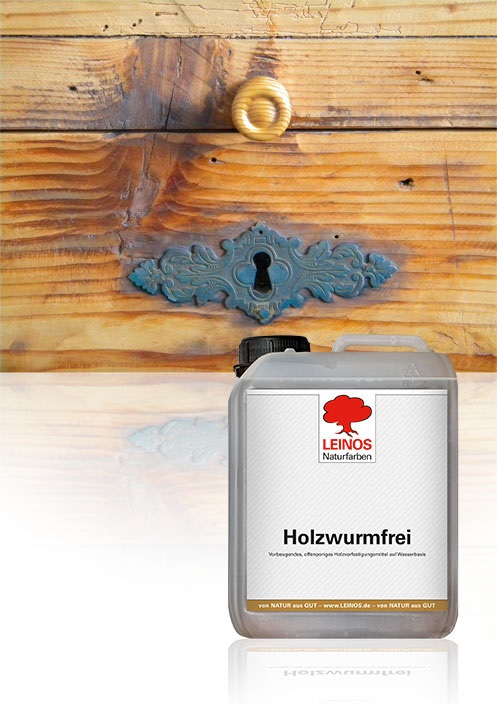
Natural, non-aggressive and non-toxic treatments for humans and animals
If you have discovered the presence of wood decay, you first need to see if the attack is small or massive. The number of holes can be a clue. A few small holes means that the wood is not badly damaged and the object can be salvaged. If the holes are very many it may be impossible to salvage anything. Especially when the wood is also chipped. You can check this by trying to break something with your hands (a chair leg, a piece of wood from the construction of the object). If it breaks easily, the piece will have to be replaced because it cannot be salvaged.
If the attack is not massive, natural, non-toxic treatments can be used.
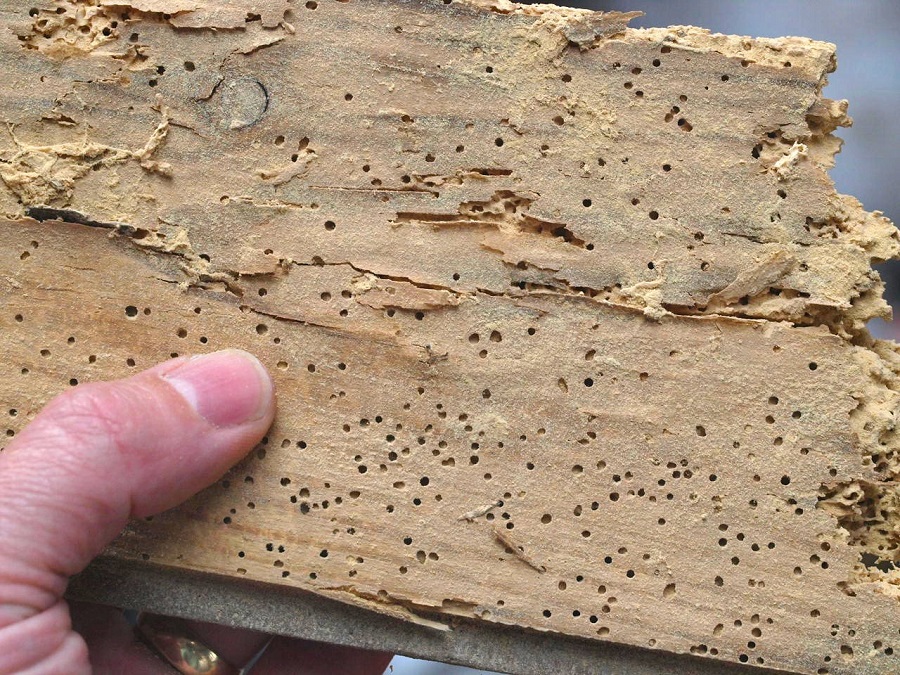
1.Treatments not involving any substances
There are treatments that can remove larvae and eggs from wood without using any substances. They are based on bringing the temperature of the wood to a level at which wood decay cannot survive.
- heat above 55°C. Small pieces of wood can be treated in a kiln at 55-65ºC. Hot air blowers can be used for larger objects. To be effective, keep the hot air source no more than 10 cm away from the holes. But be careful with finishes, in the case of furniture, as varnishes are thermoplastic and soften at high temperatures. Allow it to return to room temperature before touching the furniture. Another way to raise the temperature is to cover the piece of furniture with a black plastic sheet. Furniture wrapped in this way should be taken outside on the terrace in the sun for 2-3 days.
- temperatures below freezing. The cold is no good for the curries either. Small pieces can simply be frozen in the freezer. For large pieces, you can take advantage of the frosty winter days. Furniture is taken out onto a covered terrace and kept in the frost for a few days. Be careful not to get snow on it as it spoils the finish. In this case, the risk is cracks due to the sharp drop in humidity.
- microwave treatment. There are specialists who do such treatments for large pieces. If the piece is small, you can use the microwave, but at lower temperatures (so as not to damage the wood) and in several bursts.
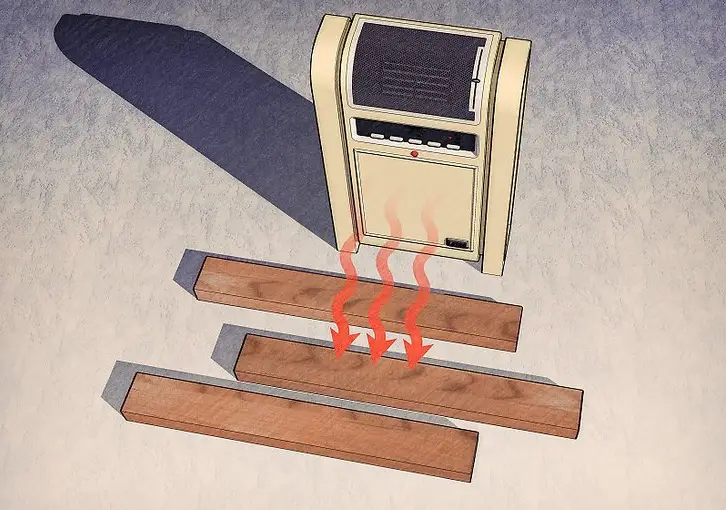
2. Treatments with non-toxic substances
There are also ways to treat wood with non-aggressive substances.
- using white spirit (turpentine, petrosin) and wax. It is a method used to treat wooden floors. The floor is washed with petrosin using a brush so that the petrosin gets into the holes. The operation is repeated 2-3 days in a row, after which the surface is sealed with wax. The holes are thus sealed and the petrosin remains inside, which kills the larvae over time.
- alcohol/vinegar/white spirit inserted into the holes using a syringe with a fine needle. The operation is repeated several times. There is also information about the use of ammonia or cedar oil, but there are opinions that they are not effective.
- rubbing objects with half an onion. I know, it seems hard to believe, but also hard to bear, because the method presupposes that the object is rubbed several times a day for 2-4 weeks. If you don't have a shed, a garage, a garage, a closet, a place to do this operation, I doubt you'll venture out to test it.
- using a bowl with acorns. Perhaps the strangest and at the same time the most interesting method seems to me to be this: a bowl of acorns is placed in the drawer of the affected furniture, inside it or just under it. Acorns are a favorite of the carrion and in time they will migrate from the furniture into the acorn bowl. From time to time check each acorn, and replace those with holes with new ones. I confess that I couldn't believe it when I read about this method, but I found it mentioned by several sources so I had to mention it.
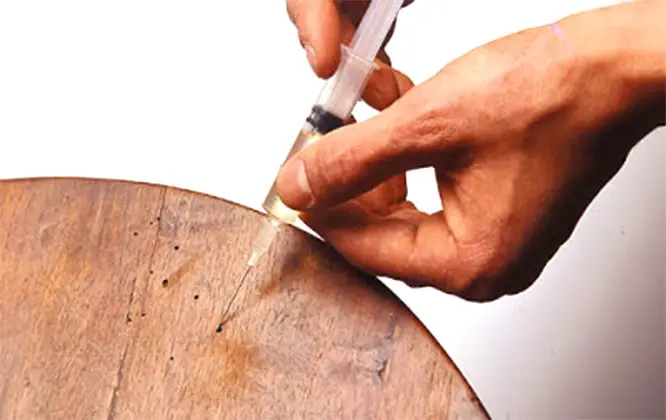
There are professional solutions and methods to deal with serious infestations of curry infestations, and if the problem is major, don't hesitate to call on them. But if you discover a few holes in an old piece of furniture or a piece of parquet flooring, I think it wouldn't hurt to try these methods first. They are not harmful and you might be able to get rid of the problem without the need for repeated gassing or spraying with toxic substances.
Those of you with workshops need to know that the only killers of chariots are spiders. So don't get so upset when they show up. They might give you a hand with the pest control.
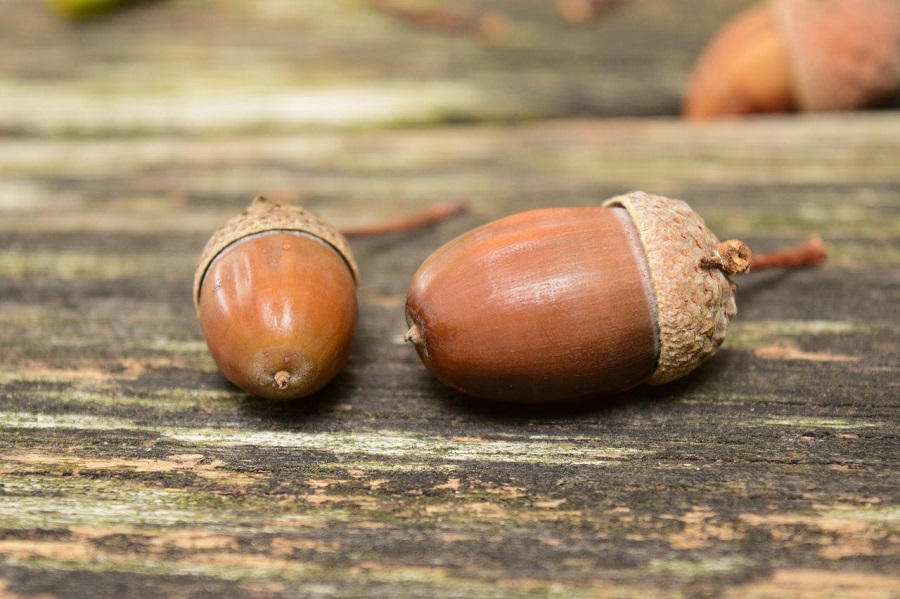
























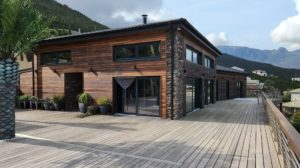
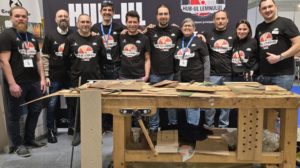
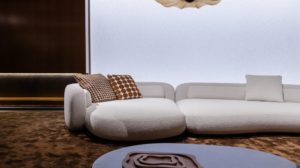

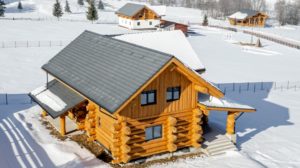
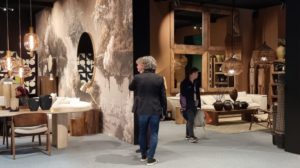

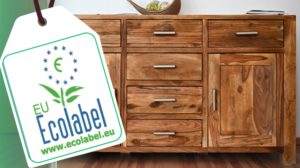




When the wood is so infested that it should be discarded, but has a value, sentimental, historical or otherwise, that justifies extreme measures for recovery/preservation, is it worth/working to stabilize it by vacuum resin impregnation?
Good evening.
You can put it in epoxy resin. You can preserve it and the carii die.
Vacuum impregnation can also be done, but it is also important how destroyed the wood is. If the wood is very brittle the procedure can damage it even more.
Wood in old houses is sometimes reinforced with sodium silicate solution. It makes it tougher, but does not protect it if it is attacked by decay. The larvae inside will continue to exist.
All the best!
Don't forget to subscribe to the printed Wood Magazine! For only 58 lei/year you can find out news in the field, discover craft ideas or trade secrets. We remind you that the content in the printed magazine is different from the one on the website. Details in the link below.
Thank you!https://revistadinlemn.ro/product/abonament-revista-din-lemn/
Good evening, can freshly cut timber (oak, pine, fir) be treated against insects? Or should it be dried and then treated? If so, which treatments would be more optimal? I am planning to build a house by myself, I bought logs and a 7,5 m long horizontal beam and I have cut them, planks, cabinets, etc.
goatherds,beam
Good morning!
It can be treated, but the effectiveness is lower. Protective substances are absorbed by the wood. The higher the water content, the lower the absorption. In addition, at humidity higher than 16-18% there are very good conditions for insect growth.
First of all you should clean the logs from the peel. It will affect the dryness and you may have a higher percentage of cracking, but remove the insects that usually live under the bark. After felling, they start to get into the wood and it might be harder to get rid of them afterwards.
Concentrated insect fungicide solutions are available on the market. They are applied, with a brush, in several layers, so that the absorption inside is greater and the protection better. Be careful, they are dangerous products and you must work with care and use protection (mask and gloves). In the link below you will find some solutions to protect wood against decay.
All the best!
https://revistadinlemn.ro/2017/08/08/despre-cari-motivul-aparitiei-ciclul-de-viata-preventie-tratamente/
hello! I need your advice! I live in a house from the 70's and the ceiling is painted pine wood and for sure in their time the wood was not treated with anything. Lately I'm seeing lots of woodworm falling through the night plus at all itches. How to get rid of them?
Hello!
From what you're saying, it doesn't sound like curries. They don't piss and fall out of the wood, even if the attacked wood is in the ceiling. Only wood dust falls out of the holes. The galleries are very winding. The carrion only comes to the surface of the wood when it is about to turn into an adult. Then it emerges from the wood as butterflies, like moths. The carrion doesn't piss, it has no business with us, only with the wood. I don't know what it could be and it would be good to consult a specialist to see what treatment to use.
All the best!
good what you have are those piss and piss in the wood .the bite of the piss bite eats very hard and passes hard .
Hello!
How could I treat 2 cubic meters of decay infested cherry veneer?
Hello!
The most appropriate would be by gassing. The wood should be placed in a closed enclosure and "smoked" with an insect fungicide that attacks cavities. There are companies that restore old furniture that do this. They put the furniture inside a truck, spray the substance inside, leave it closed for a few days and then repeat the operation.
You can also find information about careers in the link below.
All the best!
https://revistadinlemn.ro/2017/08/08/despre-cari-motivul-aparitiei-ciclul-de-viata-preventie-tratamente/
Good evening,
I was recently horrified when I saw peanut holes and nail holes in the wooden fence installed last summer.
The wood has not been finished and unfortunately not treated, just painted with a wood preservative. Mention that the wood was put over the 5 year old fence that was not affected by these curries. What do you advise me please? I've never seen anything like this before, it actually pierced the 2.5 cm thick wood and some holes are even 2-3 cm in diameter, some holes are round, others are oval.
Thank you
Hello!
They don't look like curries, they are way too big. But there are plenty of pests - bark beetle, wood wasp, pine bark beetle - that attack wood and have such large larvae. I think it's the wood wasp, but I'm not a specialist in such insects. In my opinion it was the wood laid over the old fence that was to blame. It was already infested and the humidity favoured the development. The cladding prevented air circulation, the wood did not dry properly after the rain and so the insect already in the wood developed. It is always the increased humidity that allows pests to develop.
You should call a specialist company to identify the pest, then treat the wood with the appropriate product. At this stage the existing products on the market (impregnants, sodium silicate) that are applied to protect the wood against insect attack are not effective. The attack has already taken place and you need more aggressive products. There are specialised companies on the internet that can help you (Bochemit, stop-daunatori.ro, tratamentos-lemn.ro).
All the best!
Good evening,
Thank you very much for the information I found here. They sound extremely useful to understand more about these insects. I would, however, still need an expert opinion on two issues. Some relatives are restoring a somewhat older house and, in throwing away a lot of the stuff there, we found and kept some wooden items. They all have the specific curry holes, some more, some less. Some I want to use as a support for some decorations that will stay in that house and use the wood burning technique on them. A question would be: is it possible that, in some objects, decay has disappeared by itself? (I put the wood on a white paper, and in some of them I found the specific dust the next day, but in others I didn't, even after shaking and knocking them - either they disappeared or they haven't eaten the wood yet). Another question would be: if I use any of the methods involving substances, will I still be able to get the burnt wood effect on that piece of wood afterwards? (Will it still be able to burn the same surface when I torch it?) Thank you in advance!
Hello!
The insects may disappear. The holes appear when the cart comes out of the wood. If it does not lay eggs on the same piece of wood, it is possible to leave holes without insects inside. However, this is more difficult to do and there must be no favourable conditions (high humidity in the wood, dampness in the space where the furniture is). Because the insect is moving deep into the wood, it may not be possible to dust the wood for a while. You need to watch for a longer period, because if there is a live car, wood dust will appear.
If the treatment you apply does not make a film, you can burn the wood superficially without problems. Treatments against woodworm enter the wood and practically poison the insect. Not many treatments are used that lock the woodworm inside and form a film on the wood.
All the best!
https://revistadinlemn.ro/2017/08/08/despre-cari-motivul-aparitiei-ciclul-de-viata-preventie-tratamente/
https://revistadinlemn.ro/2017/06/27/arderea-lemnului-de-la-protectie-la-colorare/
Hello, please help me with a problem: I have a house with beech parquet. There has been a carpet for more than 20 years and 4 years ago I removed the carpet and the floor was intact (unfinished, looks like new) and I scraped + lacquered it. Some time ago holes appeared in some places (different rooms) and now I removed some boards and there were these little live worms. The problem is that I need to scrape and varnish the floor again, but I'm afraid that these holes will appear again and I want to know if there is an effective solution that I can spray over the floor and then varnish it. Thanks
Hello!
If the flooring looks good and everything has changed in the last 4 years, it is possible that the humidity in the house has changed and the wood decay larvae have become active or have been brought in from outside (an infested piece of wood) and have developed amidst the increased humidity.
There are aggressive solutions with which you can treat wood. Curry larvae are very resistant, so you will have to repeat the treatment. You can find such products at Casa Iancu, or Bochemit products. Make sure that the product is one that kills the insects, not one that prevents their appearance. The preventive ones are much weaker and seldom have any effect against larvae or eggs.
Below is a link with more information about curries and treatments.
All the best!
https://revistadinlemn.ro/2017/08/08/despre-cari-motivul-aparitiei-ciclul-de-viata-preventie-tratamente/
Hello. I also need some advice. We have just moved into a house that we have been building for two years. We used dried softwood in the garden for the whole attic but untreated. Cleaned of bark, planed, etc. When the bridge was atticed, the carpenter used some planking we had but about 20% has bark. And I think we have cavities now. Climbing into the bridge for maintenance I hear sporadic grinding noise and after lifting the bark off a few planks there is that fine sawdust under the bark, wood eaten but no gully marks, just gaps for dozens of cm. Doesn't seem to be attacking the bridge resful. Could I get rid of the curry with the heat leetle? Should I put some heaters in the attic to raise the temperature? Especially on these hot days? Or do I have to take all the heating out of the attic and clean it? Thanks for your answer and I look forward to it. Have a nice day!
Good evening!
More than likely those planks with bark on them brought decay, but the development was also helped by higher wood humidity.
I don't think you can raise the temperature so much that you get rid of them completely. But you don't have to remove the scanner either.
An effective treatment is Bochemit's and you can apply it with a brush, a brush or a pump on the lump as it is now.
Many of our readers say they have used it successfully
More information can be found in the link below.
All the best!
https://revistadinlemn.ro/2020/07/30/cum-scapi-de-cari-si-alti-daunatori-ai-lemnului-solutii-anticarii-lemn/
Hello, f interesting article. I would like to ask you how do they transmit from infested wood to clean wood? By direct contact, or can they travel distances to reach the clean one?
I'm setting up a small carpentry shop in an attic, and I've noticed a few rafters affected by cavities. Can I get to the pieces of wood I am going to work on from there?
Thank you
Good evening!
When it reaches maturity, the larvae in the wood start digging until they are very close to the surface of the wood. There it develops into a pupa and then an adult. The adult insect breaks through the thin wood and emerges. For 3 weeks it flies around looking for a place to lay its eggs, after which it dies. The eggs are laid in the cracks of healthy wood. If the environment is suitable, the eggs develop into larvae that begin to gnaw the wood by burrowing deep into it. Thus begins a new cycle of life. Eggs and larvae are very hardy, and if the environment is not suitable they can survive for years until the temperature and humidity are right for development.
From the above description I think you have figured out that if there are larvae in the wood in the workshop, there is little hope that they won't get to the healthy wood. It also depends on how long the pieces to be processed will stay in the workshop and on luck.
More information can be found in the links below.
All the best!
https://revistadinlemn.ro/2017/08/08/despre-cari-motivul-aparitiei-ciclul-de-viata-preventie-tratamente/
https://revistadinlemn.ro/2020/07/30/cum-scapi-de-cari-si-alti-daunatori-ai-lemnului-solutii-anticarii-lemn/
Hello! I also have a question: how to remove the tiles from the icons/catepetasma/wooden objects inside the church without damaging them?Thank you!
Hello!
In addition to the natural solutions in the article, you can use chemical solutions. One of them is Bochemite antiquari. It is very effective and is also used by some museums to treat heritage objects. However, do not apply it to objects that have been painted with watercolour (water-based paints). Being a watery solution it can damage objects.
Find more information in the link below.
All the best!
https://revistadinlemn.ro/2020/07/30/cum-scapi-de-cari-si-alti-daunatori-ai-lemnului-solutii-anticarii-lemn/
Hello. Very interesting article. I have a new apartment and in the summer I noticed some cockroaches that look exactly like the ones you presented. I cleaned the apartment and they haven't appeared for a long time (I mention that I didn't live in the place).Now I moved into the apartment and I noticed these cockroaches again. I have a bowl of maslin on which I saw the decays received from Greece. I will treat the bowl but how do I get rid of the bugs I find around the house? I mention that I have new treated wood flooring. Thank you very much.
Good evening!
The woodworm can only be seen outside the wood as an adult. If what you have observed is in this form (insect, not larva) it is possible that the eggs have already reached other wood surfaces (including flooring).
You need to see if small, specific holes have appeared on other wooden surfaces or objects. If you find them, a clue that the larva is alive inside is the fine wood dust that appears around these holes. It's not easy to get rid of decay, but it's good to do it before it gets into other objects.
A very effective solution is Bochemit. Casa Iancu also had an effective treatment. There are other piat variants, but you have to be careful that they are for fighting ticks, not for preventing infestation.
Below are 2 links that you may find useful.
All the best!
https://revistadinlemn.ro/2020/07/30/cum-scapi-de-cari-si-alti-daunatori-ai-lemnului-solutii-anticarii-lemn/
https://revistadinlemn.ro/2017/08/08/despre-cari-motivul-aparitiei-ciclul-de-viata-preventie-tratamente/
Hello,
I have a few pieces of wood recovered from the banks of a river, mainly tree roots but also pieces of oak planking that I want to use for various decorative objects.
I noticed most of them have cavity holes, what could I treat them with after cleaning them of sandy soil before giving them their final shape?
Because they are small pieces of wood, could I apply the method of keeping them hotter than 55 degrees in the oven? What would be the efficient process so that I can put them with bait and varnish afterwards or just varnish?
Thank you.
P.S. I like atypical decorations and it's just a hobby woodworking.
Hello!
As they are small pieces, you can easily use the methods of removing the caries by cooling or heating. You can also heat them in the microwave, but be careful not to overheat the wood.
After the wood has returned to room temperature, the bath and varnish can be applied.
It is possible that the wood still has no curry. The holes appear when the insect is mature and leaves the wood. If it has not laid eggs on the same wood, there are no larvae. You can check if fine wood dust appears at the holes. This is sure proof that there are hornworm larvae inside.
All the best!
ultrasound machine have you used? is it any good?
I didn't. But I understand it is used on damaged objects in museums and is effective.
Very interesting and informative your article! I've been working with wood for almost 40 years, it's one of my loves at first sight! Many years ago, I found a great article in a periodical: how the famous Stradivarius musical instruments have stood the test of time, unaffected by insects, fungi, or dampness, while retaining all their qualities, and even, like old wine, growing with time!... Well, one day, a scientist, Nobel laureate for chemistry, music lover, who is said that if he were not a great chemist, he would be a world-class violinist, intrigued by the quality of Stradivarius instruments, began to investigate them. And so, after a few years, it seems he discovered the possible secret that Stradivarius had kept well guarded!
Trees intended to become musical instruments were peeled standing in winter when the frost was at its worst, about 30-40 cm from the ground, to a height of X diameters, depending on the diameter at the base. Then in early summer they were cut, stripped of branches only, tied with heavy weights and immersed in the Venetian lagoons for about a year, then removed and left to dry on tree trunks about. Shortened to a certain length, cut to gater thickness, then immersed in large vats in borax water for a certain period, then left to dry again in sheds for approx. 1 year, after which they were stored for a further 2-3 years in the well-ventilated attics of the workshops. Only after this operation did they enter the final, thick cut for the final stage!
Thus, the researcher has even demonstrated through laboratory experiments carried out following spectroscopic and chemical analyses, that borax in combination with salts and minerals in the specific concentration of the lagoon waters, closes the pores of the wood, while forming a toxic barrier for insects and fungi, and forming an ideal osmotic sieve for humidity, this sui-generis treatment also contributing decisively to the unique acoustic, resonant quality of Stradivarius instruments!
At the end of the research, the scientist did a test: under two large, hollowed-out glass enclosures, he placed a violin, namely a Stradivarius that was his own, and another expensive, handmade violin. He then placed a large number of wooden carts in both enclosures. After a while, only his violin, the Stradivarius, was found not to have been attacked by insects at all! The experiment was repeated, with an untreated violin and a violin treated with borax solution. The treated one had 0% attacks!
HOW TO PREPARE THE SOLUTION: Borax is soluble ONLY IN WATER BRICKED TO THE BOILING POINT. AT THAT POINT, ADD THE BORAX CRYSTALS UNTIL SATURATION. On cooling, the process becomes irreversible, as no crystals remain after treatment! The solution is not toxic to skin contact or the environment, and the effect over time remains as with Stradivarius violins!
I have used this treatment both preventively and as an emergency solution, even on restorations of catapetasma and icons, with a full effect, without any damage to the treated surface, with the exception that, where it was water-based painting (tempera), I did not wipe the affected surfaces, but only injected with a syringe the borax solution in each hole, making sure that the solution does not come out more than the level of the holes of the caries! I also mention that where possible, if the wood to be treated is not covered with paint, it can be treated either with a brush or by spraying, of course, where there are holes, inject the solution with a syringe, and where possible, treat the wood by soaking it for 1-3 days, then drying it naturally, under a shed, out of the sun (NOT IN A DRYER!).
I hope you find this information useful, especially since in the end, the cost is much lower than other manufacturing options, and the toxicity is zero for inhalation, or skin contact, as well as for the environment!
Very interesting. Thanks for the addition.
Last year in the fall we built/finished the roof on the wood structure on the house with tile siding, but the wood was not treated.
In the case of roof wood (rafters, battens) and untreated, can you recommend a solution/procedure that will not affect the anti-condensation film placed over the battens (as there are gaps between the batten boards)?
Solutions that would make a film that would harden could compromise the anti-condensation film.
Would a boric acid based flame retardant solution (Bochemit antiflash) be good?
The wood doesn't seem infested, I found no evidence of infestation, the moisture content of the wood is around 15% (just below 13% at the asters), and a few rafters with values close to 18%.
You can treat with Bochemit or glass water (sodium silicate). They are water-based solutions, applied with a brush, absorb into the wood and do not form a film. These treatments can prevent infestation. I understand that there is now no sign of pests in the wood and the moisture content of the wood is good.
https://revistadinlemn.ro/2017/06/02/tratarea-lemnului-cu-silicat-de-sodiu/
https://revistadinlemn.ro/2020/08/27/tratament-preventiv-impotriva-ciupercilor-mucegaiului-si-a-insectelor-care-ataca-lemnul/
Thank you very much for your reply!
My main problem is that it will be virtually impossible for me to apply the wood treatment solution to just the wood without it getting onto the roofing sheet through the spaces between the battens.
The roof sheeting will be subject to cold/shrinkage (winter) and high heat/dilation (summer).
It is possible that certain substances in wood treatment solutions may affect the roofing film.
For example in the Bochemit OPTI F+ datasheet (https://tratamentlemn.ro/wp-content/uploads/2022/06/Fisa-Tehnica-Bochemit-Opti-FE.pdf) says that it could affect the roof film:
"COVERING SHEET: Do not apply diffusion film to freshly impregnated wood. Otherwise its functionality may be lost. Do not lay the diffusion film until the wood has dried thoroughly on the treated side. The drying time depends on the number of coats applied, the moisture content of the wood and climatic conditions, and is approximately 4-24 hours after the last application."
It is possible that some of the active substances in Bochemit OPTI F+ may affect the film.
It is interesting that other Bochemit solutions (such as Bochemit antiflash sa or Bochemit eradication) do not mention anything about roofing film in their technical data sheets. It may, however, just be an omission on their part (maybe they didn't take roof foil into account).
My guess is that the mention in the Bochemit data sheet refers to the film formed on the surface of the film preventing its diffusion property. Hence the recommendation not to put the film on wet wood. Sodium silicate does not form a film but a salt deposit which, with time, peels off.
I have a big problem and I ask you to help me with an answer by email as soon as possible and as urgently as possible.
I have a house with a brick ground floor and wooden upper floor and attic. The house has a footprint of 220 sqm. On the 100 sqm footprint I have built a 200 sqm apartment where I live. The house is built in 2004 in red and covered. The apartment's interior design I completed in 2015 since I live in it.
The part of the house unoccupied until 2022 had no windows and there was no problem. In this uninhabited part we kept some beech timber (cabinets, 10×10 cm beams, beech wood).
A few days ago I got decay in the beech lumber. So far this year it has not been, or if it has, it has been insignificant. Probably it has become more serious this spring due to the humidity (after we put the windows in).
I took out the beech lumber. But I'm afraid the decay has got into the structure of the house.
What do you advise me to do. What treatment should I apply?
If you can help me, you can also send me a message on 0747030663 - Seliman Mihai, and tell me how to contact you.
thank you
They developed from humidity and rising temperatures due to the installation of windows.
You need to check the wood side of the upstairs and attic if it has small holes and fine wood dust right next to them. It is a sure sign that you have decay. An effective treatment in this case is Bochemit Eradication. Deposib, the national distributor of the product, can help you with more information.
If you don't see any signs, it is recommended to apply a preventive treatment. Even if you have removed the source there is still a risk of infestation. Bochemit also has a good preventive material or you can use Holzwurmfrei, a natural silicate (glass water) based material.
Further information can be found in the links below.
Good luck!
https://revistadinlemn.ro/2020/07/30/cum-scapi-de-cari-si-alti-daunatori-ai-lemnului-solutii-anticarii-lemn/
https://revistadinlemn.ro/2020/08/27/tratament-preventiv-impotriva-ciupercilor-mucegaiului-si-a-insectelor-care-ataca-lemnul/
Hello! A year ago we moved into a new house. In one of the attic rooms we have two exposed wooden beams. Looking closer, I noticed a fine dust on one of them, as well as a paint swelling, for a distance of about 10 cm. I cleaned the area thoroughly and realised that it was the wood decay. The beam used was not new, it was a few years old. I didn't treat it with anything but wood varnish. Is it possible that it was infested prior to installation (3 years ago it was installed)? I understand it takes a while for the larvae to become adults. My question is how could I treat them now at this stage? Sand the beams and then treat them? Is it possible to infect the other beams, on which the board is laid, over them are plasterboard and mineral wool.
Thank you for a possible answer.
Good evening!
Yes, it is possible. The larvae or eggs were there and started to develop when they found the right conditions.
You need a concentrated solution to put in each mouth with a syringe. You can also brush or spray, but there is a risk that you don't get it the first time and have to come back. And it's practically impossible without leaving the house for a while.
You can use Bochemit Eradication, it is very effective. Natural treatments are in the article, but they are difficult to apply to beams.
If the other beams are very well covered with mineral wool and plasterboard, it is very difficult for the insect to lay its eggs there. But it can affect the wood in the house: parquet, panelling, wooden furniture.
I leave below information about the Bochemit eradication solution and about curries in general.
Good luck!
https://revistadinlemn.ro/2020/07/30/cum-scapi-de-cari-si-alti-daunatori-ai-lemnului-solutii-anticarii-lemn/
https://revistadinlemn.ro/2017/09/08/despre-cari-motivul-aparitiei-ciclul-de-viata-preventie-tratamente/
Thank you!
Hello, I have an old furniture (upholstered table and chairs) invaded by curries; I don't know how to remove them? I have tried insecticide but with no results. Please give me some advice; thank you.
Good evening!
Thistles are very resistant and cannot be controlled with just any insecticide. One product with good results is Bochemit Eradication. It is most effective applied by spraying, but can also be applied with a brush. If you can, cover furniture tightly with foil after application and leave for a few days. To be on the safe side, repeat the procedure after a week.
Below are two links to articles that may be useful to you
Good luck!
https://revistadinlemn.ro/2020/07/30/cum-scapi-de-cari-si-alti-daunatori-ai-lemnului-solutii-anticarii-lemn/
https://revistadinlemn.ro/2017/09/08/despre-cari-motivul-aparitiei-ciclul-de-viata-preventie-tratamente/
Hello!
What do you recommend for treating a musical instrument (harp) affected by cavities so that the resonance quality is not affected?
Hello!
I think products with a high salt content (sodium borate, methyl bromide, glass water, etc) should be avoided. These products tend to stiffen the wood and thus lose resonance.
One solution may be to inject white spirit (gas, petrosin) into the holes and plug with a little wax to stay inside. Leave for 2-3 days, remove the wax plug and inject again. White spirit does not affect the wood and is aggressive to the decay.
Good luck!